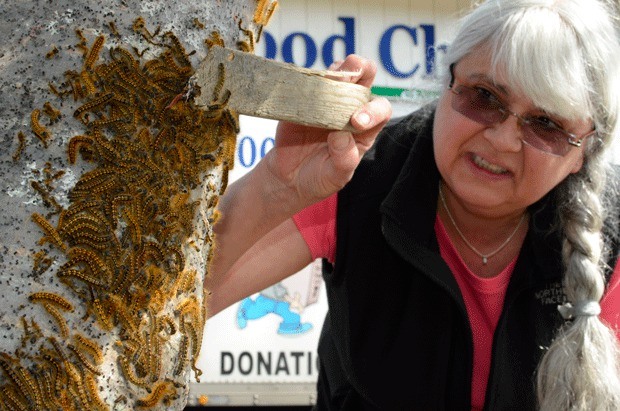Some think they’re cool, others say they’re gross.
While opinions on tent caterpillars seem to vary, there is one thing no one seems to dispute — the little buggers are everywhere.
Estimated by experts to number in the billions, they’re wiggling and munching their way across communities throughout Western Washington, and Whidbey Island is no exception.
Trees they plague, consuming leaves and coating branches like a moving bark, but nothing is out of reach: they cover mailboxes, parking lots, walls and even people can’t seem to escape.
“Oh no, you have one on your collar,” cried Becky Bell as a customer walked out of her Clinton hardware store last week.
Arnie Bauer, a Scatchet Head resident, took the uninvited hitchhiker in stride but did say the 2014 tent caterpillar bloom seems unusually large.
“They’re horrible,” Bauer said. “We had them last year, but it’s probably twice as bad this year.”
With a shudder of disgust, Bell agreed and said their numbers were staggering. There were so many on the asphalt in the parking lot last week that it was nearly impossible to walk to a store without stepping on one.
“It’s a blanket of caterpillars attacking Ken’s Korner,” she said with a laugh.
Taylor Beargeon, who works in the gardening center at the Oak Harbor Home Depot, agrees that this spring’s caterpillar crop seems extraordinarily large.
“It seems to have hit people ridiculously hard this year,” Beargeon said. “We sold out of our products real quick. We had to get more shipments in.’
According to Tim Lawrence, director of Washington State University Extension Island County, popular lore that blooms occur every seven years are a bit of a old wives’ tale.
Eggs from Malacosoma californicum, commonly referred to as the Western tent caterpillar for the webs they spin in trees, actually hatch every year, he said. Their numbers vary, however, due to variables that range from parasite populations to weather and environmental conditions.
“They build up and they drop down, they build up and they drop down; it’s a cyclic thing that’s part of nature,” Lawrence said.
Several species on Whidbey Island follow such patterns. Vole populations explode once or twice a decade on Central Whidbey, and a few years ago Greenbank Farm was under siege by swarms of sawflies.
Lawrence said the caterpillar season, which typically begins in April or May, is nearing its end and that the crawlers will soon turn into brown or tan moths. But they won’t last long either.
“Bats, birds, a number of things will have a heyday eating them,” he said.
Meanwhile, tent caterpillars are wreaking havoc on trees across Whidbey. One homeowner called the extension office last week to report that their entire orchard on Wahl Road in South Whidbey was decimated.
Clinton resident Pat Freal said alder trees near his home were hit hard, and that the caterpillars have turned to other more precious fare.
“We’re not going to have many (alders) left in our neighborhood,” Freal said. “Trouble with that is they drop off onto my apple trees.”
Lawrence said most trees, even those stripped bare, will probably survive the onslaught to sprout new leaves. There are several methods for controlling outbreaks, the best of which is bacillus thuringiensis, a bacteria spray sold at most hardware stores.
It’s toxic to insects but can be used safely in agricultural applications.
Ace Hardware in Oak Harbor is getting plenty of customers coming in seeking caterpillar remedies, said James Schestner, who works in the gardening center.
“This year, it’s a lot worse,” Schestner said of the caterpillar outbreak. “I walk to work and just about every fruit tree I see about seven to 10 nests if they’re uncared for. Ones that are cared for, I see two or three.”
A popular choice at the store is the Safer Brand Caterpillar spray, a concentrate that contains bacillus thuringiensis.
At Home Depot, the product most customers are buying is Sevin, a spray that contains the insecticide carbaryl, Beargeon said.
Carol Goldberg, a former biology teacher from Oak Harbor who also speaks on the topic of environmentally-friendly gardening practices, doesn’t like either.
“It kills the good insects, too,” she said. “They’re all part of the cycle.”
There are some free alternatives to combating the caterpillars, though Lawrence recommends against burning, and questions the effectiveness of home remedies, such as pouring diluted dish soap around the base of a tree in an attempt to sour the taste of its leaves.
“A very good method is the squish method,” Lawrence said with a chuckle.
Other than that, there’s not much to do but live with them until the cycle comes to an end, he said.
Lawrence said he expects the season will wind down over the next few weeks.
Goldberg said that trees will survive the damage. She recommends giving younger trees more water.
As for Bell, she’s lived through many past caterpillar invasions and while this one seems exceptionally large, in reality it hasn’t been much more than a headache. She’s had to keep a more careful eye on her outdoor garden displays but there’s been no real negative impact on business, she said. In fact, in some ways it’s actually been a boon.
“I’m selling the heck out of my tent caterpillar spray,” she said.




